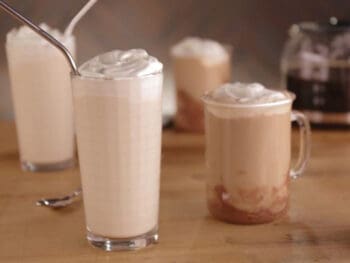Are you still not sure which method of drinking non-homogenized milk is the right one for you? Read this article to learn more.
Key Takeaways
- You can shake the milk to dissolve the cream.
- You can separate the cream and then drink the skimmed milk
- You can also drink the milk directly from the jar.
How Do I Drink Non-Homogenized Milk?
There are essentially three methods of drinking non-homogenized milk:
Method 1: Swallow The Milk with The Cream-Top
This is the easiest way to drink non-homogenized milk. Simply pour the milk into a glass and drink it without stirring. You can also drink the milk directly from the container.
Advantages of This Method
- The quickest and easiest method of drinking non-homogenized milk.
- The richness of the top part of the milk gets enhanced.
- Great for those who crave high-fat milk.
- Also great for those who desire low-fat milk.
- High nutrition content at the top due to fat-soluble vitamins and minerals.
- Depending on their dietary needs, different people can drink different parts of the milk to control their energy intake.
Disadvantages of This Method
- Inconsistency in the taste of the milk.
- The cream can clog the opening of the container.
- The nutritional content of the milk decreases in the lower part.
- The remaining milk becomes watery.
Method 2: Shake The Milk Container And Then Drink The Milk
In this method, the milk container is shaken until the cream dissolves in the milk. Alternatively, you can pour the non-homogenized milk into a bowl and then stir it to dissolve the cream.
Advantages of This Method
- The milk foam becomes shinier.
- Good for doing latte art.
- The flavor of the milk becomes consistent.
- The nutritional value of the milk becomes balanced.
- The cream does not float separately.
- The opening of the container will not get clogged by cream.
Disadvantages of This Method
- Not preferred if you want a high-fat or low-fat milk content.
- The energy value of the milk becomes consistent.
- Requires the milk to be stirred.
Method 3: Consume The Cream And The Milk Separately
In this method, you separate the milk from the cream. Firstly, follow these steps:
- Wait till the non-homogenized milk settles and the cream forms on the top. If you have fresh milk, then wait for at least 24 hours.
- Find the cream line. If you have a transparent container then you will be able to identify the cream line by looking from the sides. Otherwise you will have to make an assumption by looking from the top.
- Then separate the cream-top from the milk by using one of these processes:
Using A Ladle
- Hold the ladle with your hand.
- Gently dip the ladle into the cream. Ensure that you are not dipping into the milk.
- Let the ladle fill up with the cream.
- Remove the ladle from the milk container while carrying the cream.
- Empty the ladle into a second container.
- Repeat steps 1 to 5 until you have removed the amount of cream that you wish to remove. You may leave a small amount of cream on top of the milk. This is if you wish to retain some of the richness and texture of the milk. This will also prevent milk from getting into the ladle when you are separating the cream.
Using A Turkey baster
- Take a turkey baster in your hand and hold it at an angle.
- Press the bulb of the turkey baster:

- While pressing on the bulb, gently dip the turkey baster into the cream line.
- Stop pressing on the bulb and let it inflate. The turkey baster will suck in the cream top from the milk.
- Then place the turkey baster into a second container and press the bulb to push out the removed cream.
- Continue steps 1 to 5 until the cream is removed from the milk as desired.
Using A Lemonade Dispenser
- Pour the non-homogenized milk into a lemonade dispenser.
- Leave the milk for about 24 hours so that the cream forms.
- Pour the milk out of the dispenser by opening the spigot at the bottom.
- When the milk is emptied and only the cream remains, remove the cream using a spoon.
Using A Cream Separator
- Place a wooden board on a table. Secure the wooden board to the table using a clamp.
- Get a cream separator and place it on top of the wooden board.
- Drill screws into the wooden board to secure the base of the cream separator to the board.
- Complete the assembly of the cream separator using its owner’s manual.
- Close the milk stopper and put two containers under the two drain pipes sticking out of the separator.
- Pour hot water measuring 100 F to 110 F into the separator. Turn on the separator and let the motor run for 30 to 40 seconds.
- Open the milk stopper and let the water drain out into the two containers. Empty the containers and put them back under the drain pipes. Close the milk stopper.
- Pour the milk into a boiling pot and heat the milk to 100 F to 110 F.
- Pour the milk into the cream separator.
- Wait for 30 seconds and then open the milk stopper. The milk and the cream will now get separated and fall into different containers as shown here:

Now that the milk has been separated from the cream, you can drink the skimmed milk directly. The milk, however, will lose its richness depending on how much cream you extracted. But you can also consume the cream.
This is how you can use the cream:
- You can make ice cream using the cream.
- The cream can also be used to make sour cream.
- You make butter from the cream as well.
- Snow ice cream can also be made using the cream that you separated.
- The cream can be transformed into whipped cream too.
- You can also eat the cream directly or eat it after adding sugar.
- You may spread the cream on your morning toast.
- The cream can also be easily turned into cheese or yogurt.
Advantages of This Method
These are the advantages of separating the cream from the milk before drinking it:
- The cream can be processed into another dairy product and consumed separately.
- Reduce the fat content and energy value of the milk.
- Great for those who do not like cream in their milk.
Disadvantages of This Method
These are the disadvantages of separating the cream from the milk:
- The nutritional value of the milk decreases.
- Requires more time and effort than other methods.
- Needs an apparatus for separating the cream and a different container to store it.
- The richness of the milk gets significantly diminished.
- The milk has to be settled first.
Is Drinking Non-Homogenized Milk Safe?
Yes, drinking non-homogenized milk is safe. As a matter of fact, drinking non-homogenized milk is safer than drinking homogenized milk as long as it is pasteurized.
Homogenized milk can be harmful to you as the fat in it becomes almost indigestible. It can make Xanthine Oxidase XO enzyme in milk, which is supposed to be excreted by the body, more absorbable. This type of milk can also contribute to heart disease, diabetes, and allergies.
So, if you want to drink milk safely, drink non-homogenized milk instead.
Frequently Asked Questions
Which is Better: Homogenized or Pasteurized Milk?
Homogenized milk and pasteurized milk are not better than each other. Homogenization and pasteurization are two different processes. Milk that is pasteurized can also be homogenized.
Is Homogenized Milk The Same as Cow Milk?
No, homogenized milk is not the same as cow milk. Cow milk is milk that is produced by a cow. Homogenized milk, on the other hand, is milk whose fats are smaller in size and mechanically homogenized. It can be produced by cow’s milk as well as other kinds of milk.
Which Milk Can We Drink without Boiling?
Pasteurized milk that has been stored correctly can be drunk without boiling. This is because pasteurized milk undergoes a chemical process that kills off the harmful microbes. You can drink this type of milk without concern for your health.
Conclusion
So, now you know all there is to know about how to drink non homogenized milk. Drinking milk that has not been homogenized is both safe and a very unique experience. But not many people know how to drink this type of milk. I hope reading this article helped you easily decide how to drink non-homogenized milk.
That is all for today. Thank you for reading my article. Goodbye and goodluck with your non-homogenized milk!
- How Long Does Vegan Butter Last? Mystery Solved - January 9, 2024
- How Long Does Vegan Mayo Last - January 2, 2024
- From Pot to Plate: How Long Does Vegan Chili Last in The Fridge? - December 26, 2023







